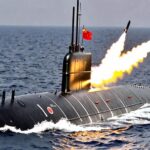China’s Nuclear-Powered Submarine Incident Raises Alarm Over Naval Accountability
China’s first Zhou-class nuclear-powered submarine sank at its dock earlier this year, highlighting potential issues in military accountability. Satellite imagery confirmed the loss, with no return to the dock. The incident underscores China’s ambitions to enhance its naval capabilities amid ongoing modernization efforts, raising concerns about transparency and oversight within its defense sector.
Recent reports indicate that China’s latest nuclear-powered submarine, part of the Zhou-class line, sank while docked at a shipyard near Wuhan in the spring of the current year. This information was disclosed by two officials from the United States Department of Defense. The Zhou-class submarines are characterized by a distinctive X-shaped stern, designed to enhance their underwater maneuverability. Satellite imagery captured on March 10 by Maxar Technologies confirmed the submarine’s presence at the port, displaying its notable X-shaped tail. However, subsequent images from June revealed that the vessel did not return to the dock following its reported sinking. A senior U.S. defense official noted, “It is not surprising that the PLA Navy would try to conceal the fact that their new first-in-class nuclear-powered attack submarine sank pierside.” The peculiar activities observed at the shipyard drew attention from experts such as Tom Shugart, an adjunct senior fellow at the Center for a New American Security. He pointed out irregularities in crane placements that suggested unusual operations. He remarked, “I have never seen a bunch of cranes clustered around (one spot),” further stating that the submarine’s larger dimensions and distinctive tail indicated it belonged to a novel class of submarines. He observed that typically, submarines remain at the shipyard for outfitting for several months after being launched, yet this submarine was absent from the site. The Chinese government has prioritized modernizing the People’s Liberation Army (PLA) Navy, which includes increasing its nuclear submarine capabilities. Presently, the PLA Navy operates a combination of nuclear-powered and diesel-powered submarines, while the United States Navy boasts a fleet of 53 fast attack submarines and additional ballistic missile submarines. The implications of the sinking for China’s submarine capabilities remain uncertain, particularly regarding whether the vessel had already been loaded with nuclear fuel. A spokesperson from the Chinese embassy in Washington, D.C. commented, “We are not familiar with the situation you mentioned and currently have no information to provide.” Meanwhile, reports indicate that China is enhancing its production capabilities for new submarines, with forecasts suggesting the PLA Navy could possess 65 submarines by 2025 and 80 by 2035. As the largest navy in terms of ship count, China’s PLA Navy currently has 370 platforms compared to the U.S. Navy’s 219 warships. The entire incident raises pertinent questions regarding the accountability and oversight within China’s defense sector, which has historically faced challenges associated with corruption.
The context surrounding the event involves China’s significant efforts to modernize its military capabilities, most notably the expansion and enhancement of its naval forces. The Zhou-class submarines represent a strategic investment in advanced naval technology, aiming to position the People’s Liberation Army Navy (PLAN) among the foremost maritime military forces globally. Establishing a formidable submarine fleet is essential for achieving a balanced military capability relative to the United States, long identified as China’s primary competitor. As tensions rise in the Pacific, the implications of such incidents become even more critical in terms of global security and military strategy.
In summary, the sinking of China’s newest nuclear-powered Zhou-class submarine raises important questions regarding the state of the People’s Liberation Army Navy and its operational transparency. As China continues to modernize its naval capabilities, incidents like this highlight potential weaknesses in accountability within the Chinese defense industry, as well as the rising geopolitical complexities of naval power dynamics in the region.
Original Source: www.cnn.com







Post Comment